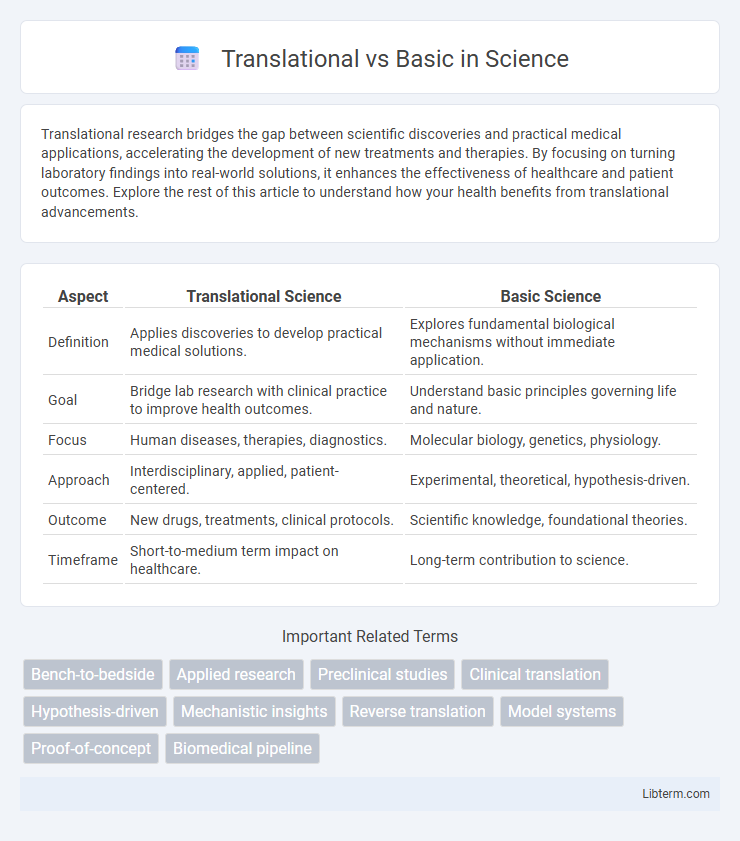Translational research bridges the gap between scientific discoveries and practical medical applications, accelerating the development of new treatments and therapies. By focusing on turning laboratory findings into real-world solutions, it enhances the effectiveness of healthcare and patient outcomes. Explore the rest of this article to understand how your health benefits from translational advancements.
Table of Comparison
| Aspect | Translational Science | Basic Science |
|---|---|---|
| Definition | Applies discoveries to develop practical medical solutions. | Explores fundamental biological mechanisms without immediate application. |
| Goal | Bridge lab research with clinical practice to improve health outcomes. | Understand basic principles governing life and nature. |
| Focus | Human diseases, therapies, diagnostics. | Molecular biology, genetics, physiology. |
| Approach | Interdisciplinary, applied, patient-centered. | Experimental, theoretical, hypothesis-driven. |
| Outcome | New drugs, treatments, clinical protocols. | Scientific knowledge, foundational theories. |
| Timeframe | Short-to-medium term impact on healthcare. | Long-term contribution to science. |
Introduction to Translational and Basic Research
Translational research bridges the gap between laboratory discoveries and clinical applications, aiming to convert basic scientific findings into practical treatments and interventions. Basic research explores fundamental biological processes without immediate application, providing the foundational knowledge necessary for advancements in medicine. Both research types are essential, with basic research fueling innovations that translational research develops into therapies improving human health.
Defining Basic Research
Basic research is the systematic study aimed at understanding fundamental principles and mechanisms without immediate practical application, focusing on generating new knowledge about underlying biological, chemical, or physical processes. It explores hypotheses, theories, and phenomena to build a foundational scientific framework that informs later applied studies. This type of research contrasts with translational research, which emphasizes applying basic science discoveries to develop practical solutions, diagnostics, or treatments.
Understanding Translational Research
Translational research bridges the gap between basic science discoveries and their practical application in clinical settings, accelerating the development of new treatments and therapies. It involves multidisciplinary collaboration to convert laboratory findings into effective medical interventions, enhancing patient outcomes and public health. Understanding translational research emphasizes its role in transforming molecular and cellular knowledge into real-world healthcare solutions.
Key Differences Between Translational and Basic Research
Translational research bridges the gap between laboratory discoveries and clinical applications, aiming to convert basic scientific findings into practical treatments or interventions. Basic research focuses on understanding fundamental biological processes without immediate application, driven by curiosity and the pursuit of knowledge. Key differences include their objectives, where translational research targets real-world health outcomes, while basic research emphasizes theoretical insights and mechanisms.
Goals and Outcomes of Basic Research
Basic research aims to deepen scientific understanding by investigating fundamental principles and mechanisms without immediate practical applications in mind. The primary goals include generating new knowledge, formulating theories, and uncovering underlying biological, chemical, or physical processes. Outcomes of basic research often lead to foundational discoveries that enable future translational research and technological innovations.
Practical Applications of Translational Research
Translational research bridges the gap between basic scientific discoveries and practical applications, accelerating the development of new diagnostics, treatments, and medical interventions. It focuses on converting laboratory findings into clinical practices, improving patient outcomes and healthcare effectiveness. This research facilitates personalized medicine, drug development, and public health strategies by directly applying experimental data to real-world medical challenges.
The Research Spectrum: From Bench to Bedside
Translational research bridges basic scientific discoveries with clinical applications, accelerating the development of new therapies and medical interventions. Basic research investigates fundamental biological mechanisms without immediate clinical goals, providing the foundational knowledge essential for translational efforts. The research spectrum moves from bench (laboratory experiments) to bedside (patient care), ensuring that insights from molecular and cellular studies effectively inform diagnostic and treatment strategies in healthcare.
Challenges in Bridging Basic and Translational Research
Bridging basic and translational research faces significant challenges, including the complexity of translating molecular discoveries into clinical applications and the gap between laboratory models and human biology. Limited funding and regulatory hurdles often delay the progression of promising basic science findings into effective therapies. Effective communication and collaboration between multidisciplinary teams are essential to overcome these barriers and accelerate innovation in medical research.
Collaboration Between Basic Scientists and Translational Researchers
Collaboration between basic scientists and translational researchers enhances the development of novel therapies by integrating fundamental discoveries with clinical applications. Effective teamwork accelerates the translation of molecular and cellular insights into diagnostic tools, treatments, and preventive strategies. Shared data platforms and interdisciplinary communication foster innovation and bridge the gap between laboratory research and patient care.
Future Trends in Research Integration
Future trends in research integration emphasize the convergence of basic and translational sciences to accelerate innovation in disease treatment and personalized medicine. Advancements in artificial intelligence and multi-omics technologies enable seamless data sharing and collaborative platforms, enhancing the predictive power of preclinical models. This integration fosters a more dynamic feedback loop, allowing rapid validation of hypotheses and more efficient clinical trial designs.
Translational Infographic

 libterm.com
libterm.com